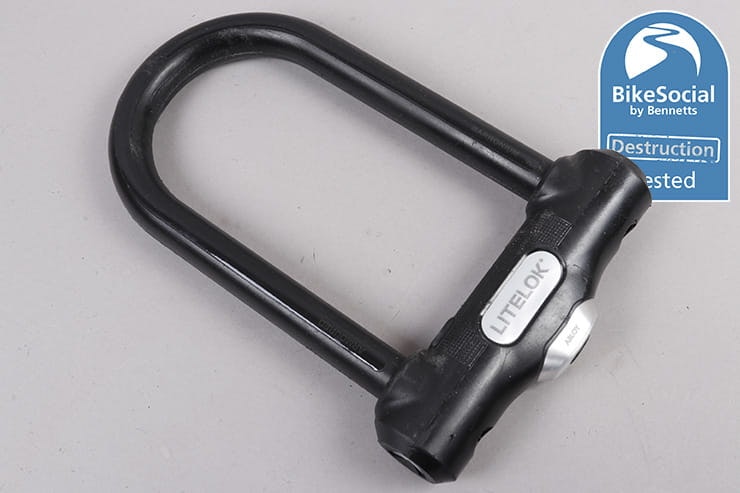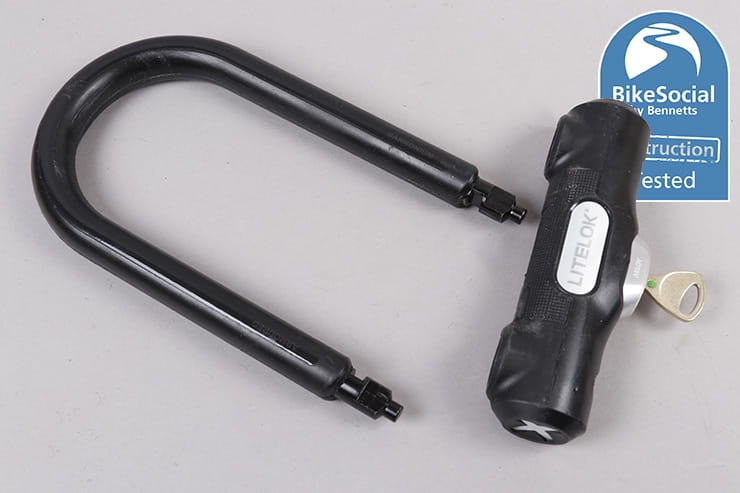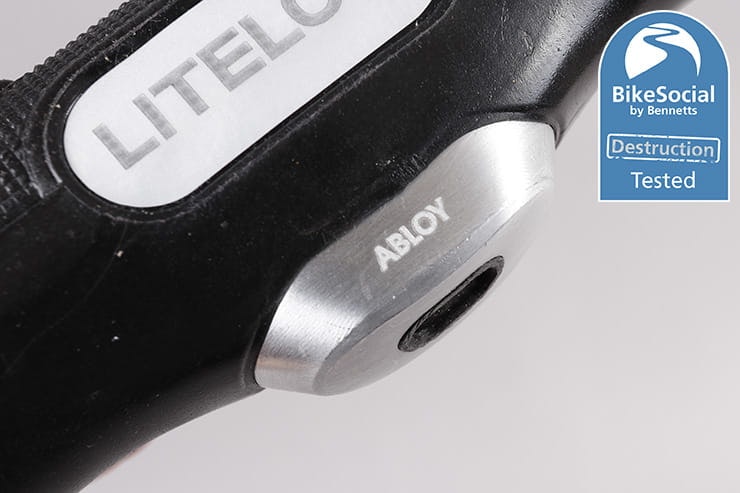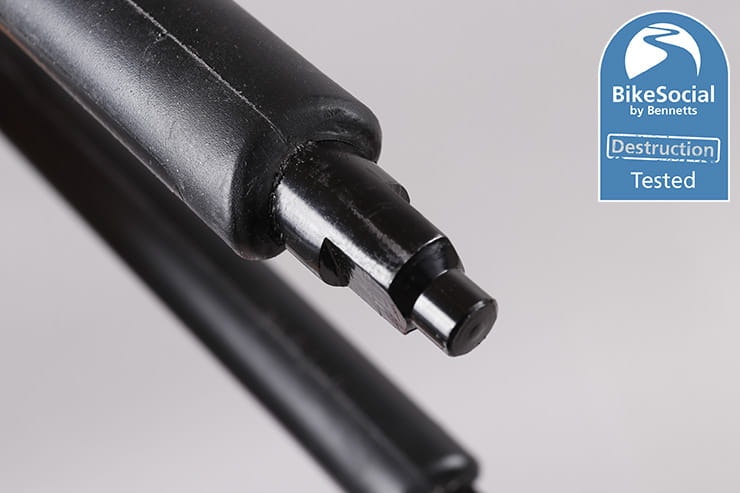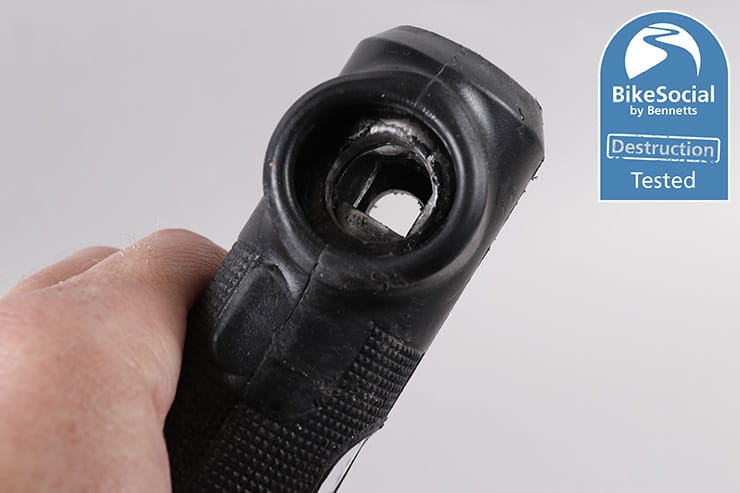Litelok X3 review | Angle-grinder-resistance D-lock tested
By John Milbank
Consumer Editor of Bennetts BikeSocial
10.11.2022
Date reviewed: November 2022 | Tested by: John Milbank | RRP: £249.99 | Weight: 2.08kg | www.litelok.com
The Litelok X3 we’re reviewing here is due to be available for pre-order from November, however this is a full production version.
Slightly larger and heavier than the Litelok X1, the Litelok X3 uses the company’s proprietary ‘Barronium’ in the shackle and body, which founder and CEO Neil Barron told me is a ceramic composite fused to hardened steel.
The lock’s covered in a plant-based rubber material that prevents damage to the bike’s paintwork, as well as reducing the chances of anything it’s packed with in your luggage getting harmed. It’s designed to rattle as little as possible, but that's more of an issue for cyclists than motorcyclists. My only observation is that I’d love to have the option of a brightly-coloured lock body, to dissuade would-be thieves and to remind the owner that it’s fitted.
When buying any security, as well as checking our in-depth bike lock destruction test reviews here, you should look for Sold Secure approval. Part of the Master Locksmiths Association, the Motorcycle Diamond standard is currently its highest achievable for bike locks, and the only one that includes an angle-grinder attack. Locks certified to Motorcycle Gold have not been put through an angle-grinder attack by Sold Secure, though all of our reviews use this tool, so you can easily compare products to find what’s best for you.
Highly resistant to attack
Fits around some motorcycle wheels
Very versatile and portable
Shackle can be a little stiff in the body
I’d like the option of a brightly-coloured lock body
Not the class-leader in all grinder attacks
Size and weight
By my measurements, the Litelok X3 weighs 2.08kg and has a shackle thickness of 24 to 26mm. This means it won’t fit through many chain links, though I found that by trimming off the end of the coating on one side, I was able to use my usual portable chain. With the coating removed, the diameter of the Litelok X3 shackle is 18-19mm.
The shackle’s internal dimensions are 100mm x 195mm, which – impressively – means it’ll fit around the front rim and tyre of my R1250GS (spoked wheels) or 1999 ZX-6R. It would’t quite fit around my 2001 Honda VFR800 front wheel, but it will of course go around the front or rear cast spokes, which still offer very good security and prevent the bike being pushed away.
While by no means a deal-breaker, the Litelok's shackle can be a bit awkward to get out of the body of the lock at times, due to the tight tolerances.
I was also able to get this through the holes in the hub of my BMW’s front wheel, which is extremely hard to attack.
Resistance to attack: bolt-croppers
Measuring up to 19mm thick under the rubbery coating, the Litelok X3’s shackle is completely resistant to attack even from the largest 42” bolt-croppers. The coating splits, but the ceramic/metal composite is virtually unmarked.
To see how this compares with the other locks we’ve tested, check out our best motorcycle locks for home and away.
Resistance to attack: drill
Attempting to drill the cylinder out of the lock body was unsuccessful.
The Litelok X3 uses an Abloy Sentry cylinder, which is said to be the most pick-resistant device available. Other, completely unassociated security companies have had similar praise for the Abloy, so it’s good to find in what is a premium product. Under ideal conditions with plenty of practice, I’m sure any lock could – eventually – be opened using specialist tools, but this is simply not an attack method seen in real-world motorcycle theft.
To see how this compares with the other locks we’ve tested, check out our best motorcycle locks for home and away.
Resistance to attack: lump hammer
I have an old Triumph Tiger front wheel that I use for testing locks, and with this looped around one of the cast spokes, no amount of prolonged attack with a lump hammer caused anything more than tearing to the rubbery coating.
This lock is designed to be fixed to the bike, so shouldn’t be susceptible to a sledge-hammer attack, but to be sure, I put it on a makeshift anvil and struck it repeatedly, where it showed no signs of deforming or cracking.
To see how this compares with the other locks we’ve tested, check out our best motorcycle locks for home and away.
Resistance to attack: angle-grinder
Cutting the shackle using a mains grinder and 1.0mm DeWalt Inox discs, it took longer than anything I’ve ever attacked, and I burned through four discs doing it.
Once cut, there’s very little movement in the two sides of the shackle – while I was able to get it off the narrow cast spokes of the Tiger wheel, it wouldn’t have come off had it been attached around the rim and tyre, or a thicker spoke on many other bikes. In which case it would likely take eight cutting discs to remove.
It’s most likely that a thief will be using a battery-powered portable grinder. Having benchmarked these (and petrol-grinders) against the mains grinder I use for testing, I can say with confidence that the Litelok X3 is incredibly resistant to attack, and will eat through many discs (and batteries) before yielding.
I cut through the body of the lock, but this was far more difficult than the shackle, so didn’t provide any advantage.
Note: Bennetts BikeSocial's testing now includes specialist diamond-tipped metal cutting disks, as well as a top-of-the-range DeWalt portable battery-powered grinder. When attacking the Litelok X3 with this device, cut times were reduced and the disc survived. However, it still took significantly longer to cut the lock than a standard D-lock (or U-lock). It's also important to note that police forces are not currently reporting the use of these discs, and that results with them can be very mixed – we've found that abrasive discs still tend to offer the highest speed on most motorcycle security. They are not the 'do-it-all' solution for motorcycle thieves. At the time of updating (April 2024), the Hiplok DX1000 offers the greatest resistance to a diamond disc attack.
A typical theft is carried out using tools stolen from a van, not new ones, but our testing reflects the worst-case scenario of a thief with a full complement of high-quality and well-maintained tool. It's also based on constantly updated reports from the police of what is being used in crime in the UK.
To see how this compares with the other locks we’ve tested, check out our best motorcycle locks for home and away.
Product: Litelok X3
Weight as tested: 2.08kg
Bolt cropper attack: GOOD
Sledge hammer attack: GOOD
Angle grinder attack: OUTSTANDING
Litelok X3 review: Verdict
At £249.99, the Litelok X3 is not cheap, though it is less than the new Hiplok DX1000 (reviewed here), but that lock has a larger shackle than the X3 so fits over more wheels, and it has the edge when it comes to attack with a diamond disc.
Like any good security, this should very much be considered an investment. Decent security should last a lifetime, and will significantly reduce the chances of you suffering the misery and hassle of having a bike stolen. It’ll also help protect any no-claims discount you might have.
While the Litelok X3 can prevent your bike being pushed away – the most common form of theft as criminals will leave it somewhere for a few days to check if a tracker’s fitted – it won’t stop the machine being picked up and put in the back of a van; for that, you’ll need some way to secure the motorcycle to something solid, so consider using a chain too.
When out and about you’ll be unlikely to be able to carry anything much thicker than about a 14mm chain, and this will always be the weakest part of a security set-up like this (until Litelok hopefully incorporates this tech into links). Personally, I often simply carry an 11mm chain as it balances a reasonable resistance to attack with true portability.
Police forces and other industry professionals all recommend a layered approach to security: using different devices in combination to make your bike far less attractive to thieves than the others nearby. It works, and by having the Litelok X3 as part of that set-up, you’ve made your bike one of the hardest to steal on the street.
The Litelok X3 is now my personal choice of portable lock, and very much worthy of a BikeSocial recommendation.
To see the other chains and locks tested by Bennetts BikeSocial, click here and be sure to regularly check for the discounts available through BikeSocial membership.
See the Litelok X3 being attack tested
Sledge-hammer, lump-hammer, drill, bolt croppers and angle grinder theft testing
